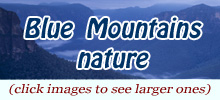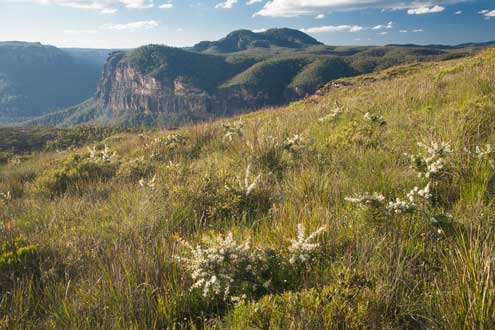 Sydney Montane Heath on Mt Hay Range, still developing several years after a fire. Shrubs of Hakea flower above a mass of sedges and Lesser Flannel Flowers (Actinotus minor). (Ian Brown)
Sydney Montane Heath on Mt Hay Range, still developing several years after a fire. Shrubs of Hakea flower above a mass of sedges and Lesser Flannel Flowers (Actinotus minor). (Ian Brown)
In these harsh conditions the sclerophyllous traits of plants are highly developed.
Complex ecological relationships between the heathland plants, fauna and fire, and their scattered distribution in the landscape, have led to high biodiversity.
Heathlands are shrubby, largely treeless communities that occur in just under 2% of the Greater Blue Mountains. They are restricted to shallow, nutrient-poor, sandy soils on rock benches in exposed situations, usually ridge tops.
They merge into dry sclerophyll forests in less exposed situations with deeper soil and into upland swamps where moisture is greater.
Two classes of heathlands occur in the Greater Blue Mountains, with altitude being the determining factor for which occurs where.
Sydney Coastal Heaths
Sydney Coastal Heaths occur on the lower sandstone plateaux in the eastern part of the Greater Blue Mountains (as well as nearer the coast around Sydney), where they occupy shallow, moderately damp soils, mainly on ridge tops.
They contain a rich array of sclerophyllous shrubs and an equally rich complement of sedges and herbs.
Many patches are relatively small (on average, 4 hectares), and occur on and around rock platforms on exposed sandstone ridge tops jutting above the forests.
They occur mainly in Blue Mountains, Nattai and southern Wollemi national parks, and less commonly in Yengo National Park, probably due to conditions there being drier.
Sydney Montane Heaths
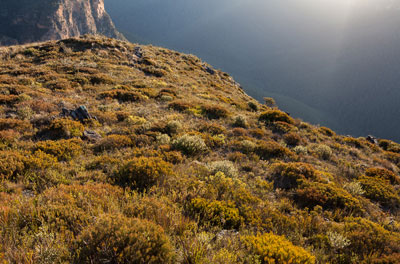 ‘Middle-aged’ Sydney Montane Heath near Lockleys Pylon, dominated by Dwarf Sheoak (Allocasuarina nana) and Hairpin Banksia (Banksia spinulosa). These heaths commonly occur on windswept plateau edges with shallow, low-nutrient soils and relatively high fire frequency. (Ian Brown)
‘Middle-aged’ Sydney Montane Heath near Lockleys Pylon, dominated by Dwarf Sheoak (Allocasuarina nana) and Hairpin Banksia (Banksia spinulosa). These heaths commonly occur on windswept plateau edges with shallow, low-nutrient soils and relatively high fire frequency. (Ian Brown)
In the Greater Blue Mountains, they are far more extensive, occurring in scattered locations across the high plateaux from western Wollemi through to the tablelands of Kanangra-Boyd National Park.
They are prominent on the panoramic ridges of the upper mountains as well as on the spectacular pagodas of Gardens of Stone and western Wollemi.
Patches of these heathlands are often small, averaging 3 hectares, although there is considerable variation above and below this size.
Threatened Ecological Communities of heathlands
Genowlan Point Allocasuarina nana Heathland (endangered) occurs only within Mugii Murrum-ban State Conservation Area.
Heathlands Flora
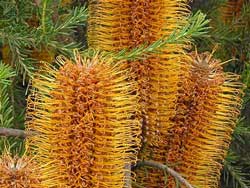 Heath-leaved Banksia (Banksia ericifolia subsp. ericifolia)
Heath-leaved Banksia (Banksia ericifolia subsp. ericifolia)
photo by: Alan Page
Its 10-15mm long rosemary like leaves identify it.
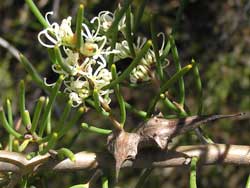 Dagger Hakea (Hakea teretifolia)
Dagger Hakea (Hakea teretifolia)
photo by: Alan Page
It's named after its distinctively shaped fruit and has white flowers in summer.
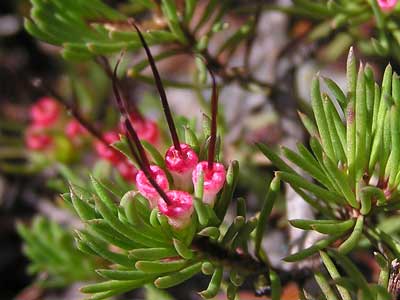 Darwinia taxifolia subsp. taxifolia
Darwinia taxifolia subsp. taxifolia
photo by: Alan Page
Darwinia species are endemic to Australia and are named after Erasmus Darwin - Charles Darwin's grandfather.
Heathlands Landscapes
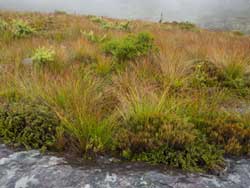 Sydney Montane Heath
Sydney Montane Heathon Mt Hay Range
photo by: Ian Brown
The species composition of these heaths varies with site moisture and time since fire.
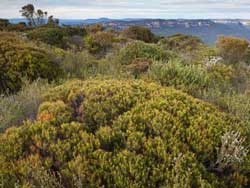 Sydney Montane Heath
Sydney Montane Heathon Kings Tableland
photo by: Ian Brown
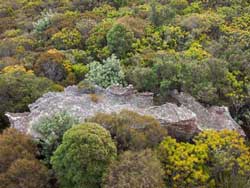 Very mature Sydney Montane Heath, Kings Tableland
Very mature Sydney Montane Heath, Kings Tableland
photo by: Ian Brown
It is now an interesting site of heath succession, as young plants grow amongst the blackened skeletons.
